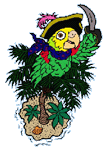 |

|
||||||||||
 |
 |
 |
 |
 |
 |
|
 |
||||
|
One Method of Introducing New Things by Terry Beaudoin "My bird is afraid of anything new!" "I tried giving my bird a new toy and he hates it!" - or the much dreaded version of this statement - "Remember that really expensive toy you recommended, well my bird hates (or is terrified) of it." Or, "I tried offering my bird (insert food of choice here) and he wants nothing to do with it." The introduction of new things, toys, perches, food, etc., can be tricky for many pet bird owners. Even birds that have been heavily socialized and have had many different things offered to them could sometimes be spooked or just uninterested in the new item. These behaviors are not the acts of a psychotic animal but the instinctive responses of an animal that is still very far from being domesticated. Most species of wild birds (parrots included) rely almost exclusively on how quickly they react to a perceived danger. The word "perceived" is very important. Many times the danger isn't real but many of the birds that stick around to find out are lunch for some hungry predator. Keeping this in mind it becomes easier to devise different methods to avoid the severe fear/flight response or the less severe avoidance response we see birds give to the introduction of new things in their environment. The method that works most often for me has its basis (as does much of the best behavioral training information) in looking at wild bird behavior and trying to incorporate those behaviors into how we interact with our pet birds in our homes. In the wild one of the only situations where a bird will immediately show interest in a new object is when another bird already has that object or is very interested in it. So keeping this in mind I have found that if an owner places their bird on the floor, couch, etc. and then sits about three feet away with the new toy, perch, food or other item and acts very interested in it (pick at it, rub it, put your hand inside of it if possible, or if it is food - either eat it or do an award winning performance of acting like your eating it and that the only thing that would make you happier would be if there were more ). Do NOT call or in any way try to coax your bird to the toy, as this is far more likely to cause problems than to help. Most birds will come over in short order to see what is so captivating to you - anyone who has ever tried to type or write while their bird is nearby has found out how difficult it can be to do with a bird attached to their hand, keyboard or pen. Sometimes it seems like the more you might want to keep whatever you have to yourself - the more interesting that object is to the bird. When the bird finally comes over to see what you have be sure to let it decide when to actually touch it or climb on it - again, in the beginning do NOTHING to either encourage or discourage the birds curiosity - it will develop in its own time. Once the bird has formed the initial opinion that this new object is probably OK you may proceed slowly to offer the new item in the normal manner. This is just one of the methods that can be used to introduce new things to your bird. If this method doesn't work for you be aware that there are others. We feel that it is the best method in most situations. Our birds, however, constantly remind us that there are exceptions to every rule. Additional Behavior articles:
|
Copyright
© 2000-2003 Parrot Island, Inc.
Send mail to webmaster with
questions or comments about this web site.